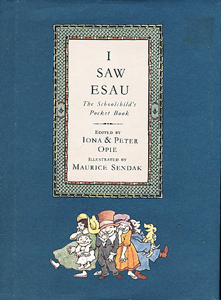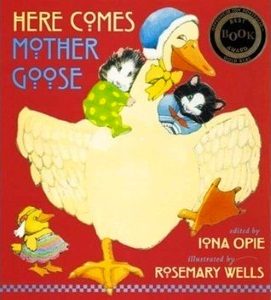Reviews of Selected Books Edited by Iona Opie
 I Saw Esau: The Schoolchild's Pocket Book
I Saw Esau: The Schoolchild's Pocket Book
edited by Iona and Peter Opie; illus. by Maurice Sendak
Of Interest to Adults Candlewick 160 pp.
6/92 1-56402-046-0 $19.99
Generously embellished with illustrations ranging from full-page compositions to vignettes illuminating individual verses, this newly reissued edition of the book which first appeared in 1947 is certainly an event in 1992 publishing annals. Those familiar with the Opies' work will consider the revised compilation, with its scholarly and intriguing notes — and in its new format — an attractive addition to their folklore collections; those who expect A Hole Is to Dig (Harper) or settings reminiscent of typical preschool versions of Mother Goose may be somewhat surprised. As Iona Opie indicates in the introduction, these are "clearly not rhymes that a grandmother might sing to a grandchild on her knee." Rather, they belong to the hidden culture of childhood. A few, like "Sticks and stones may break my bones," might be taught to children by an older person, but most are the chants learned in the schoolyard or on the street which were never sanctioned by adult approval. They were not used at home or within earshot of those with tender sensibilities who would be shocked, to cite one example, by this variant of a familiar theme: "Roses are red, / Violets are blue. / The shorter the skirt / The better the view." Many of the rhymes are universally comprehensible, such as the tongue twister "How much wood would a woodchuck chuck / If a woodchuck could chuck wood?" Others are dependent on knowledge of British regionalisms, such as the wordplay found in the "Twentieth-Century Alphabet" (a version of ABC): "A for 'orses" which translates into "hay for horses" or "E for brick" which signifies "heave a brick." Sendak's illustrations help in deducing these and other puzzlers. Owing much to psychological theories, they tend to make overt what seems less menacing or crude when sung or chanted by children unaware of the possible dark origins of their games — a case in point being the voracious nursing babe who devours its mother in the illustrations accompanying the rhyme which begins "I one my mother," proceeds through the numbers through seven, and concludes with the homophone "I ate my mother." The effect is somewhat like that of viewing childhood through a Hogarthian lens. On the whole, there are wide swings in tone from the cruel to the merely capricious, for the characters as portrayed seem more like miniaturized street-wise adults than children — or perhaps they are reminders that the conventional images of childhood are far too idealized and that adults in reality are hapless Gullivers threatened by a mass of Lilliputians waiting for the signal to rise against their oppressors. Certainly an invaluable resource for students of children's literature, the book will have definite appeal for Sendak fans and is, of course, significant for the study of twentieth-century illustration. MARY M. BURNS
From the September/October 1992 issue of The Horn Book Magazine.
 My Very First Mother Goose
My Very First Mother Goose
edited by Iona Opie; illus. by Rosemary Wells
Preschool Candlewick 108 pp.
9/96 1-56402-620-5 $19.99
What can be said about yet another Mother Goose book? Quite a lot in this case. The book is not a definitive Mother Goose, with familiar rhymes such as Old Mother Hubbard missing and less familiar ones included, and there are no footnotes or sources. But as a first Mother Goose, the book does its job superbly. Sixty-eight rhymes have been selected with parents, babies, and toddlers firmly in mind. The book is oversized yet perfect for lap holding, and the rhymes are attractively placed on each page and nicely placed throughout the book so as not to overwhelm parents and babies with too many images and too much black type. Central to the success of the book are Rosemary Wells's illustrations. The orange-gold cover shows Mother Goose as a large, white, cap-bedecked goose standing on a blue-checkered border that will attract parents and grandparents who may remember Blanche Fisher Wright's edition from their own childhoods. Riding on Mother Goose's back, however, are four of Wells's signature animals — a gray kitten, brown bear, black rabbit, and tiny tan mouse — looking hopefully at the viewer in invitation and anticipation. The checkered border is picked up throughout the book to provide a nice cohesion. The first rhyme is an appropriately familiar "Jack and Jill," and the final "Matthew, Mark, Luke, and John, / Hold my horse till I leap on," provides a quiet good night. Unlike some editions of Mother Goose that crowd many rhymes within the pages, these rhymes are leisurely paced. While some human characters appear, Wells's lively animals are the most well delineated and appealing. A tiny mouse under the Queen's chair sticks its tongue out at Pussycat; an elegant hog rides home from market in an open limousine. Throughout the book familiar characters reappear to connect the rhymes and give parents and babies more chances to interact with the pictures. We know that interaction that takes place between parent and baby over the pages of a good book is a primary factor in literacy learning, and My Very First Mother Goose makes such important work pure joy. BARBARA KIEFER
From the November/December 1996 issue of The Horn Book Magazine.

![]() Here Comes Mother Goose
Here Comes Mother Goose
edited by Iona Opie; illus. by Rosemary Wells
Preschool Candlewick 108 pp.
10/99 0-7636-0683-9 $21.99
This companion volume to My Very First Mother Goose (rev. 11/96) is even more successful than the first — more cohesive in terms of quality of art and totality of design, more venturesome in the selection of the nursery rhymes. Opie has included many nonsense verses and swinging jump-rope rhymes, many of which have a benign surrealness to them (“Will you come to my party, will you come? / Bring your own bread and butter and a bun. / Mrs. Murphy will be there, / Tossing peanuts in the air, / Will you come to my party, will you come?”) that effectively levels the intellectual playing field: the words are as much nonsense to the adult as to the child — and delight both. As in the first book, there are no source notes, and Opie has taken liberties with established texts, at times including just a fragment of a whole verse, at times even editing to affect meaning (little girls rather than little boys are here made of “frogs and snails and puppy dog tails”). But somehow the book transcends such unhappy alterations: Opie is referring to Mother Goose, but she might be speaking of herself when she says in her introduction, “More than all the others she liked the songs that run in people’s heads and make them skip instead of walk, or dance around a room all on their own” — for this collection skips; it dances. The book as a physical object is stunning: the design incorporates an inspired alternation of saturated color and white space; pages crowded with images and refreshingly spare pages; small vignettes tucked into a corner with wee type and double-page spreads consisting of one large picture and enormous type. Wells’s art — featuring a cast of guinea pigs, little yellow chicks, bunnies, and kitty cats — is captivating, even vigorous (especially Dusty Bill from Vinegar Hill — surely one of the toughest-looking baby bunnies in all children’s literature). So here comes Mother Goose — and, to those who welcome this book into their lives, many, many hours of shared reading pleasure. MARTHA V. PARRAVANO
From the November/December 1999 issue of The Horn Book Magazine.
RELATED
ALREADY A SUBSCRIBER? LOG IN
We are currently offering this content for free. Sign up now to activate your personal profile, where you can save articles for future viewing.







Add Comment :-
Be the first reader to comment.
Comment Policy: